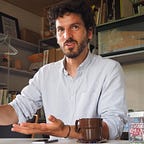[2/3] What I learned from visiting Fablabs & Makerspaces in Japan.
Last November and December, I had the opportunity to be able to work from Japan. So I went to visit and meet up with the Fab. scene in East Japan. As a matter of fact, even if most of the time I didn’t follow the protocol of making a proper appointment, I have to mention that I always have been happily welcomed. Often being invited for beer and dinner. Japanese Fab. people are really fabulous people.
Here is a list of the Fab. spaces I’ve visited and the team I’ve met : FabLab Shibuya, part of Co-Lab / &Fab, from Loft and MUJI stores, powered by FabLab Shibuya / Happy Printers / FabCafé Tokyo / Makers Base, avec Project Esin / Proto.Tokyo / Akiba DMM.Make / Fablab Kamakura / Fablab Kannai, Yokohama / FLAT, Fablab Sendai / Ferment, at Fujisawa SST / Lounge Fab Space — ラウンジFabスベース, operated by FabLab Shibuya.
And here is the FabMap Japan Youka Watanabe shared with me.
Business models & spectrum of users
Like in the rest of the Makers world, fablabs and maker spaces showed a large variety of business models ; from DMM.Make based on incubating startups, Makers Base, Happy Printer or FabCafé on enabling independants to start their brand, FabLabs that were juggling with public investment and private sector assignments, sponsored by large companies like Ferment or &Fab, or even teams like Proto.Tokyo dedicated to cunsulting.
When I shared this draft list of Fab. spaces in Paris region, people in Tokyo were impressed to see such a large number of maker spaces already operating in Paris area. Specially when you compare Tokyo Metropolitan area (35 millions people) to Paris area (12 millions people).
Nevertheless, when discussing with the Fab. scene, there would be the same types of endusers ; from leisure / hobby / professional & independants / corporations.
Even if all of them are looking to develop their project, among these users appeared 2 main types of profiles : the people for whom a project is an oportunity to build from prototype to a new business, and the people for whom a project is an opportunity to learn from collaborative making to new skills and knowledge.
Porportionally to the spaces in Paris, the spaces I visited in East Japan were dedicated to the general public and to corporations or start-ups, rather than to free-lancers and independants workers. In Japan, the number of Freelancers and independant business is lower than it is in Europe and even more than in USA. Over there, a study from Elance-oDesk affirm that 34% of US workers are freelancing. And with fewer independant workers, how does the coworking and the fablab scene succeed to live in Japan?
Actually, when looking a bit deeper into that topic, I realized that the US freelancers and not always happy freelance workers. As The Economist puts it, often “freelance happens out of necessity, rather than by choice.”
The pourcentage of freelancers happens to be correlated to the pourcentage of unemployement. While in USA and in Europe it rose after 2008, in Japan, it reamained around 4%. It would be interesting to compare with the evolution of coworking spaces in Japan, to see if they are targeted at freelancers or tiny companies.
Continue reading : [3/3] What I learned from visiting Fablabs & Makerspaces in Japan.
